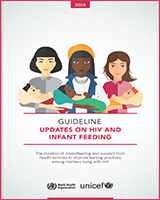A subgroup of the Guideline Development Group considered the implications for supporting infant and young child feeding in conflict and emergency settings. The subgroup reported back to the full Guideline Development Group. The following points summarize the discussions and suggestions.
The Guideline Development Group noted the wide range of challenging settings in which the updated recommendations would be relevant, including acute, protracted and recurrent conflict and emergency settings. The Group noted that emergencies commonly disrupt and overwhelm the routine systems of support at all levels including drug supply, the availability and capacity of health workers and authorities and of communities to respond. Physical and health system disruptions undermine optimal breastfeeding and complementary feeding, and these are compounded by the stress of mothers and families.
Because data collection is complex, evidence is lacking on how best to support and guide infant feeding practices in emergencies. Nevertheless, considering the balance of risks of feeding options and the impact on child survival is paramount. For example, Jakobsen et al. (2003) reported that, during the first three months of the war in Guinea-Bissau in 1998, children 9–20 months of age who were no longer breastfed were six times more likely to die than were children still breastfeeding.
HIV adds specific challenges and considerations to infant and young child feeding.
Crises change risk profiles, and the relative risks and acceptability of various feeding practices among mothers and communities therefore need to be re-evaluated. In such settings, the acceptable, feasible, affordable, sustainable and safe criteria for determining the appropriateness of use of replacement foods may still be useful.
The prevailing policy on HIV and infant feeding may not be in accordance with international recommendations on infant and young children in emergency settings.
ARV drug supplies may be disrupted, or no ARV drugs may be available at all.
Girls and women may be especially vulnerable and at additional risk of HIV infection.
The fear of HIV transmission among families may result in inappropriate responses, including recommendations to avoid breastfeeding in the absence of testing and the distribution of infant formula.
The Guideline Development Group considered that WHO should develop specific guidance on HIV and infant feeding in emergencies to address issues including:
integrated responses that consider health, HIV, preventing the mother-to-child transmission of HIV, infant and young child feeding, etc.;
emergency preparedness by national authorities, including community responses;
key infant and young child feeding emergency principles that apply and should be integrated into situations in which HIV is a concern;
managing the interruption of supplies of ARV drugs; and
consistent, accurate communication.
Next steps
The Guideline Development Group acknowledged that addressing the complexities of HIV and infant feeding in emergencies was beyond the scope of the current technical consultation in terms of time, scope of the evidence presented and the profile of participants present. Members proposed that WHO convene a meeting specifically on HIV and infant feeding in emergencies with participants to include United Nations agencies, operational nongovernmental organizations working in nutrition and health, government representatives and nutrition and health agencies. Such a meeting should seek to clarify programmatic issues and develop a framework and key principles regarding infant feeding and HIV in emergencies to help put the current HIV and infant feeding guidance into practice. The meeting should seek to collaborate with and learn from the HIV community and other sectors. In the absence of formal research evidence, case studies could be developed to inform thinking and direction, with consideration of qualitative research (such as the CERQual [Confidence in the Evidence from Reviews of Qualitative Research] approach). An important output of such a meeting would be to identify evidence gaps and set priorities for research questions to address. The meeting would inform the update of the operational guidance on infant and young child feeding in emergencies (IFE Core Group, 2007) endorsed by the World Health Assembly being updated in 2016.

